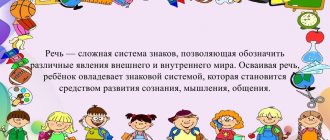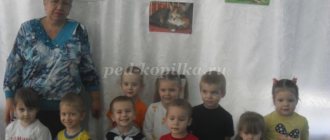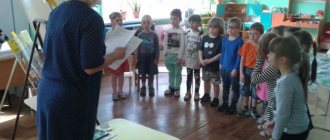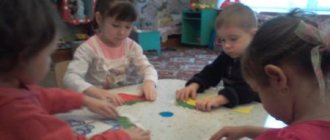Forms of work on speech development
The development of speech in the garden occurs in specially organized classes and in everyday life. With children 2-3 years old, the teacher plays different games, invites the little ones to do speech exercises, tells fairy tales, reads nursery rhymes and short poems by heart. Classes are conducted in subgroups.
The teacher talks with the children in the morning, during a walk, during games, after a nap or in other free time. The conversation arises spontaneously or is planned (the teacher sets the task of repeating a learned poem, automating an intractable sound, etc.). If the teacher talks to one child, then this is individual work. This is how speech develops in children.
When and how does speech develop?
Speech development is recommended to begin with the birth of a child. Already in infancy, the baby isolates human speech from the flow of other sounds, listens to the words of adults, and tries to imitate what he hears. Up to one year, the child “hoots” (makes sounds similar to [g], [k], [x]), “booms,” babbles, and after the first round date in his life he tries to pronounce words.
In a preschool institution, close attention is paid to the speech of pupils. Purposeful work on the formation of speech skills begins already in early age groups. Speech development in the first junior group is one of the most important educational tasks, the solution of which determines the child’s education at the next age stages.
Communicative activity develops in the process of communication. To understand how a teacher works to develop children’s speech, it is necessary to consider the forms of communication characteristic of preschoolers.
Planning work on speech development
Speech development in preschool educational institutions is carried out on the basis of a long-term plan, which is drawn up by the teacher in accordance with the kindergarten education program or other program document. The long-term plan is drawn up in the form of a list or table. The name of the month, topic and program content of the lesson are indicated. An example of a long-term plan is shown in Table 1.
Table 1. Long-term work plan for October
| № | Lesson topic | Program content |
| 1 | A cat came to us | To consolidate ideas about a toy, expand the active vocabulary in the field of onomatopoeic words (“meow”, “bang”), nouns (“kitty”, “cat”, “ears”, “tail”), adjectives (“smooth”, “fluffy” ), verbs (“go”, “give”). Develop attention and thinking. Cultivate responsiveness and kindness. |
| 2 | For a walk in the autumn forest | Form ideas about the autumn forest, expand the active vocabulary in the field of nouns (“autumn”, “forest”, “tree”, “leaves”), adjectives (“yellow”, “red”), verbs (“turn yellow”, “fall” ), prepositions (“with”, “on”). Develop attention, perception, thinking. Cultivate curiosity. |
| 3 | … |
Based on the long-term plan, a summary of speech development is drawn up. In addition to the topic and program content of the lesson, the notes indicate the material used (toys, pictures, etc.), describe the preliminary work (if carried out), describe in detail the remarks and actions of the teacher, and the expected answers of the children. A summary is also a kind of plan. Speech development occurs systematically. Young specialists write detailed plans and notes, but an experienced teacher needs a long-term plan.
Recommendations for parents on speech development in children
For the development of speech in the first junior group to be successful, the efforts of the teacher are not enough. Much depends on the parents and close relatives of the child. Teachers advise mothers and fathers to talk with their children more often, discuss various questions (“why does a flower grow?”, “what color is the sky?”, “what should we feed the cat?”, etc.).
An adult's speech should be clear and moderately loud. You cannot copy a child’s statements or pronounce words the way a child does.
With the help of parents, you can perform puppet shows based on the plots of familiar works, and memorize short poems. The teacher places a list of books and texts of poems in the parent's corner.
You should be attentive to children's issues. If you can’t immediately satisfy the baby’s curiosity, then you can give the answer later, look for the necessary information in books.
You need to treat the child’s speech very carefully, follow the teacher’s recommendations, and, if necessary, contact a speech therapist.





